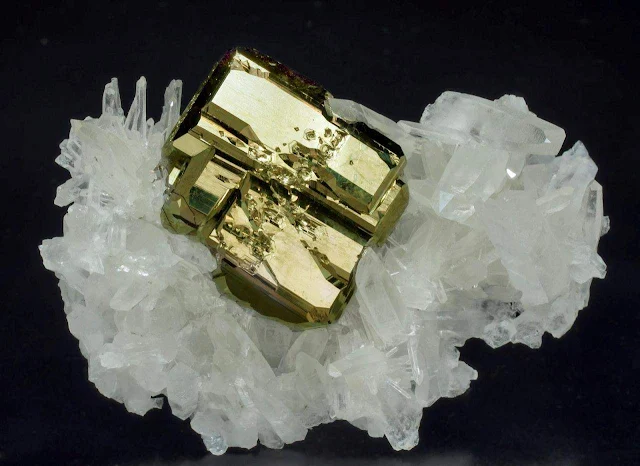“Invisible” Gold – Fool’s Gold Actually Contains Real Gold
 |
| “Invisible” Gold – Fool’s Gold Actually Contains Real Gold. Pyrite with Quartz - Huanzala Mine, Huallanca District, Dos de Mayo Province, Peru Photo: Fabre Minerals |
Confirming once more that it cannot be trusted, the metal known as fool’s gold, aka pyrite, can contain bits of the real thing, according to an Australian-Chinese research team.
Curtin University research has found tiny amounts of gold can be
trapped inside pyrite, commonly known as "fool's gold," which would make
it much more valuable than its name suggests.
This study,
published in the journal Geology in collaboration with the University of
Western Australia and the China University of Geoscience, provides an
in-depth analysis to better understand the mineralogical location of the
trapped gold in pyrite, which may lead to more environmentally friendly
gold extraction methods.
Lead researcher Dr Denis Fougerouse
from Curtin’s School of Earth and Planetary Sciences said this new type
of “invisible” gold has not previously been recognised and is only
observable using a scientific instrument called an atom probe.
“The discovery rate of new gold deposits is in decline worldwide with the quality of ore degrading, parallel to the value of precious metal increasing,” Dr Fougerouse said.
“Previously gold extractors have been able to find gold in pyrite either as nanoparticles or as a pyrite-gold alloy, but what we have discovered is that gold can also be hosted in nanoscale crystal defects, representing a new kind of “invisible” gold.
“The more deformed the crystal is, the more gold there is locked up in defects. The gold is hosted in nanoscale defects called dislocations – one hundred thousand times smaller than the width of a human hair – so a special technique called atom probe tomography is needed to observe it.”
Dr Fougerouse said the team also explored gold extraction methods and possible ways to obtain the trapped gold with less adverse impacts on the environment.
“Generally, gold is extracted using pressure oxidizing techniques (similar to cooking), but this process is energy hungry. We wanted to look into an eco-friendlier way of extraction,” Dr Fougerouse said.
“We looked into an extraction process called selective leaching, using a fluid to selectively dissolve the gold from the pyrite. Not only do the dislocations trap the gold, but they also behave as fluid pathways that enable the gold to be “leached” without affecting the entire pyrite.”
In a Conversation article accompanying the paper’s release, Fougerouse wrote that it was previously suspected that bits of gold in pyrite crystals came about at different times, and the two minerals glommed together later on.
The pyrite specimen the team inspected suggested that the two minerals can crystallize simultaneously, in a single process. Fougerouse also noted that different methods could be used to release the gold particles from their pyrite prison, which could be more energy efficient than the typical means of gold extraction, reactor-based oxidation, or smaller-scale methods like separating the gold from slag by smelting the ore.
The study is supported by the Australian Research Council and the Science and Industry Endowment Fund. Dr Fougerouse is affiliated with The Institute for Geoscience Research (TIGeR), Curtin’s flagship Earth Sciences research institute.

%20(1).webp)






